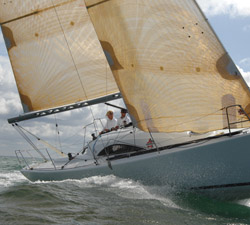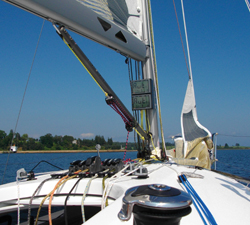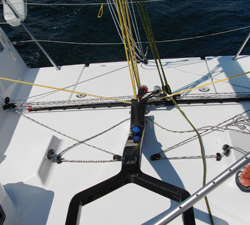Archambault 31
 What a treat to have the owner of the new Archambault 31, Ann Acland, on board with us when we took Anticipation out for a sail in Mahone Bay the day before Chester Race Week started. We were also joined by the North American representative for Archambault and Aigle, Philippe Paturel, and Canadian sailor, Jeff Brock. The boat scooted along in the light breeze without effort and the tiller, mounted with a handle extension, was very responsive to the wind because of the 6’3″ spade rudder. The UK sails made out of the San Francisco loft were made of carbon fibre, done with a new heat-sealed process without using glue.
What a treat to have the owner of the new Archambault 31, Ann Acland, on board with us when we took Anticipation out for a sail in Mahone Bay the day before Chester Race Week started. We were also joined by the North American representative for Archambault and Aigle, Philippe Paturel, and Canadian sailor, Jeff Brock. The boat scooted along in the light breeze without effort and the tiller, mounted with a handle extension, was very responsive to the wind because of the 6’3″ spade rudder. The UK sails made out of the San Francisco loft were made of carbon fibre, done with a new heat-sealed process without using glue.
Ann, who sails out of the Royal Nova Scotia Yacht Squadron, scoured the market looking for a 30-foot racer/cruiser that had sleek lines with a clean moulded interior (without a lining) and with no front bulkhead leading into the v-berth so that you could easily store sails flat without bending them. “After spending a lot of money on sails,” said Ann, “the last thing you want to do is to have to fold them in half when storing them on the boat.” After Ann test sailed her last summer in 35(+) knots of wind, she knew the A31 could go offshore in pretty much any condition.
 She sleeps 6 with an aft double-berth, a well-appointed galley, enclosed aft master suite and a spacious head that combines a work/storage area. With the large cockpit with a super-sized aft locker (plenty big enough for a lift raft, fenders, and lifejackets) and 1.82m (6 ft.) headroom below; the A31 rivals any other modern 31-footer in creature comforts. The interior has light warm wood, clean white finishes and modern mircrofibre upholsteries. Handle holds below match the through-hull bolts that hold on the jib tracks. The vacuum-infused, resin glass sandwiched hull, injection infusion structural liner and composite deck is built using an environmentally sound process while eliminating airborne toxins.
She sleeps 6 with an aft double-berth, a well-appointed galley, enclosed aft master suite and a spacious head that combines a work/storage area. With the large cockpit with a super-sized aft locker (plenty big enough for a lift raft, fenders, and lifejackets) and 1.82m (6 ft.) headroom below; the A31 rivals any other modern 31-footer in creature comforts. The interior has light warm wood, clean white finishes and modern mircrofibre upholsteries. Handle holds below match the through-hull bolts that hold on the jib tracks. The vacuum-infused, resin glass sandwiched hull, injection infusion structural liner and composite deck is built using an environmentally sound process while eliminating airborne toxins.
The 14 HP Nani diesel with a sail drive option for 20 HP has access from four sides and is a dream for any mechanic should they ever have to work on it. The same holds true for the electronic panel where you don’t have to be childsize to work on it. The fuel tank is opaque plastic which allows for easy visibility of fuel consumption. The water tank has a bladder that is easily removable for cleaning. All doors  are fabric with zippers for privacy. The ice box is standard as well as the two-burner propane stove. There are options for an oven or refrigerator.
are fabric with zippers for privacy. The ice box is standard as well as the two-burner propane stove. There are options for an oven or refrigerator.
This smaller version of the renowned A35 and A40rc has only been in production for a year and is performing exceptionally well in Europe and Australia. This will be the first A31 to be raced in North America. Once again, the naval architectural team of Joubert, Nivelt & Mercier has designed a thoroughbred IRC Racer-Cruiser. With a 40% ballast ratio – 3050 kg. (6746 lb.) overall – the A31 outperforms in all conditions. It’s IRC rating is 0.998, PERF New England 108 and Nova Scotia 99.
All lines are led back to the cockpit and with a 105% jib, it is easy to handle with the Harken self-tailing 46.2 speed winches. From a ‘go fast’ perspective, the boat has built-in barber haulers so that you can change how the jib is sheeted outboard without having to move the jib car.
There are also Harken 40.2 cabin top winches used for the spinnaker that is launched and taken down through the front hatch. It has a mast head spinnaker, but is also set up to race with an asymmetrical one. The carbon fiber spinnaker pole  is also standard in the racing package.
is also standard in the racing package.
There are teak toe holds for the skipper, especially nice for those of us who are vertically challenged in height. The main trimmer sits aft of the helmsman to handle the 9:1 purchase main, 8:1 backstay and Ronstan traveller. The instruments were Nexus and allowed for GPS/USB from laptop to outside monitor.
One really unique feature that I found fascinating was the swim ladder. It is concealed in a tube off the transom. With one hand you can reach down, turn the lever and release the ladder. It is made out of polypropylene and moulded plastic handles to prevent rusting, and is easy to hang on to for swimming or dragging.
The boat is easily raced with 6 or 7 crew; the sail controls and helm can easily be handled by women or juniors that make it a versatile boat to have a mixed, all-women, or guys only crew. As a J/24 owner, I was very impressed that there was an inspection port hole in the deck for the lifting bridle to come through when hauling.
By Katie Nicoll























